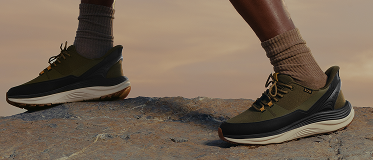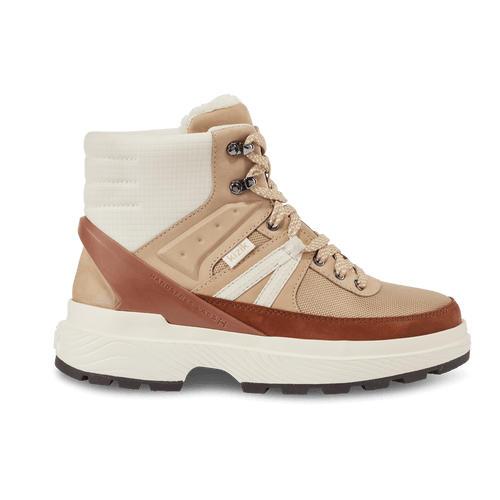Struggling to fit shoes on a toddler or noticing more trips than usual? Choosing the right shoe size prevents discomfort and supports healthy, happy feet for all their growing adventures.
Interested in discovering more? Your pals here at Kizik have you covered. Read on to unravel the mysteries of kids' shoe sizing, grab practical tips, and learn how to keep those little feet comfy without bending over backward.
Why does the right shoe size matter?
Before we dive into the nitty-gritty of measuring and fitting, you might be wondering why obsessing over the right shoe size for your kiddo matters so much.
Well, nailing the perfect fit is important for a number of reasons:
No more growth-spurt grief
Kids' feet grow faster than a weed in a rainstorm, and snug shoes today could be pinch-hitters tomorrow. Right-sized shoes give those little toes room to grow without going Hulk on the seams.
Playground cred
Ever seen a kid sit out because their shoes were giving them grief? Comfy shoes mean your little adventurer keeps scaling jungle gyms and scoring soccer goals without a pause.
Blisters be gone
Tight shoes are a recipe for the kind of blisters that turn little walkers into limpers. The right fit means their feet stay happy, and those dreaded blisters don’t make it to the after-school report.
Straight-up strutting
Good fit supports more than just feet. It keeps kids upright and balanced, whether they’re navigating the school hallway or the backyard obstacle course.
Shoes that endure
When shoes fit right, they wear out less quickly. That means you're not back at the shoe store every other month, and those sneakers get to clock more playground hours.
Stumble-proof
Oversized shoes might sound like a good idea for growth spurts, but they're trip traps. Shoes that fit keep pace with pint-sized sprinters without tripping them up.
What are the signs of a poorly fitting shoe?
Spotting poor-fitting shoes on kids isn’t always obvious—they may complain, but often subtle signs go unnoticed, especially when they're busy playing.
Here’s what to keep an eye on:
- Red alert on the ankles: If taking off their shoes is like unwrapping a gift of red marks and indentations around their feet, those shoes are too tight.
- The stumble conundrum: Notice your mini-me morphing into a mini-falling-machine? Shoes that are too big might just be the culprits. It's the slip-and-slide that no one enjoys.
- One-sided shoe story: Peek at the soles. Is one side partying harder than the other? That uneven wear could mean the shoes are out of sync with your child’s natural step, turning walks into wobbles.
- The "weird-feels" report: When your kid says their shoes feel ‘funny,’ it’s not the ha-ha kind. It might be their way of saying, "Help, these feel weird!" Kids know when something’s up even if they can't nail the lingo.
- Shape-shifting shoes: Notice the shoes warping like they’re in a funhouse mirror? That’s them telling you they’re under too much pressure, squishing instead of supporting those growing feet.
Watch for tell-tale signs to avoid footwear issues—when the shoe fits, adventures roll on smoothly, blister-free!
What should you know about kids' shoe sizes?
You’ve spotted the signs that it’s time for new shoes, but before diving into sizes and styles, here are a few key things to know. Kids' shoe sizes vary widely—not just because they grow quickly, but because sizing isn’t uniform across brands. Sizes are grouped into three main categories: infants, toddlers, and youth.
These categories align with age ranges, but remember—age is just a guide. The perfect fit depends on measuring their actual foot size.
Here’s the rundown:
- Infants' sizes: From about 0-4, these are for the littlest ones and usually go up to about 9 or 10. These sizes are crucial during the early walking stages as they help in balancing and coordinating those first wobbly steps.
- Toddlers' sizes: Roughly sizes 4.5-10, these are for children from about 1 to 4 years old. Toddler shoes are built for those who’ve mastered walking and are on the move, exploring every nook and cranny.
- Youth sizes: Starting around size 10.5, they go up to about a youth size 7, which then transitions into adult sizes. Shoes in this range need to accommodate a wide variety of activities and rapid growth.
Because children's feet grow so fast, sometimes as much as a size every few months, it's essential to measure their feet regularly. Measure both feet and always fit shoes to the larger foot.
A properly fitted shoe should have about a thumb’s width of space from the tip of the shoe to the end of the longest toe to allow for some room to grow without sacrificing support and stability.
How can you measure your child’s foot accurately at home?
Accurately measuring your child's foot at home makes shoe shopping easier, ending the guesswork and returns for a perfect fit right from your living room.
Here’s how to make sure those new shoes are just right, even before they take their first steps outside.
Get the right tools
All you need is a piece of paper, a pencil, and a ruler or measuring tape. Make sure your little one is wearing the type of socks they'll likely wear with the new shoes for the most accurate measurement.
Prepare the paper
Place the paper on a flat, hard surface like a tiled floor or a table. If the floor is carpeted, use a hard book or board under the paper to stabilize it.
Stand them up
Have your child stand on the paper with their full weight evenly distributed on both feet. It’s important they stand straight and still to get an accurate measurement.
Trace the foot
Carefully trace around the outline of your tiny tot’s foot with the pencil held as vertical as possible. If they wiggle too much, try turning it into a game to keep them engaged and still.
Measure the length
Using your ruler or measuring tape, measure the distance from the heel to the longest toe. This is the foot length. Record the measurement in both inches and centimeters to match any shoe sizing guide you might use.
Measure the width (optional)
For kiddos with particularly wide or narrow feet, measuring the width can be just as important. Measure the widest part of the foot which is usually right below the toes.
Compare with size charts
Use these measurements and compare them to size charts you find online or in stores. Just be sure to keep in mind that different brands can run larger or smaller, so it’s wise to check specific brand sizing charts where available.
How can you find the perfect shoe fit for your child?
You’ve got the shoe sizing for kids down and a rough idea of what size to go for, but now comes the real challenge—actually finding a pair of shoes that fit and keep up with your little adventure’s endless energy. Sound tricky? It can be.
But with a few smart moves, you can get them shoes that feel great from the first step to the last puddle they jump in.
Check the flex
If the shoes don’t bend, neither will their feet—and that’s a problem. Look for flexibility in the sole so they can move like they’re meant to. Our Orlando and Truckee Kiziks nail this; not only do they flex with each step, but they also rebound, making them perfect for restless kids.
Material matters
Breathability is your friend. If the shoe traps heat and moisture, it’ll become a sweaty, smelly nightmare. Look for shoes with breathable uppers to keep things fresh, like the cool and comfy designs we offer in our Phoenix.
Hands-free, please
Laces are cute…until they aren’t. Think of all the times your kid unties and re-ties their shoes—or doesn’t—and the inevitable trip-and-fall situation. Hands-free slip-on designs, like what we’ve mastered with Kizik, make life simpler. Step in, step out. No bending, no tying, just go.
Leave a little wiggle room
Make sure there’s about a thumb’s width between their toes and the end of the shoe. Too tight, and they’ll be complaining (or silently suffering). Too loose, and they’ll be tripping over their own feet. Find the sweet spot, and you’re golden.
Listen to the feedback
If they say the new shoes feel strange, believe them. You might think they look great, but if your kid isn’t vibing with them, the shoes won’t get worn. Keep an ear out for the “these are comfy” signal. That’s when you know you’ve found the one.
The bottom line
And there you have it—everything you need to know to conquer the wild world of kids' shoe sizing. From getting the fit just right to spotting those sneaky signs that a shoe’s past its prime, we’ve covered it all. At Kizik, we believe the best shoes aren’t just about size—they’re about making life easier for both you and your little ones.
Why settle for the hassle of traditional shoes? Our hands-free, slip-on Kid’s Kiziks are here to make shoe shopping (and wearing) a breeze—no laces, no bending, just all-day comfort and adventure-ready style. It’s time to step up their shoe game, hands-free!
Sources:
Children's Feet: How They Grow | Institute for Preventive Foothealth (IPFH)
Blisters (for Kids) | Nemours KidsHealth
Buying Children's Footwear | Tips for Healthy Feet | Patients | APMA
How to Find the Best Shoe (and Fit) for Your Child | Cleveland Clinic






























Leave a comment
This site is protected by hCaptcha and the hCaptcha Privacy Policy and Terms of Service apply.